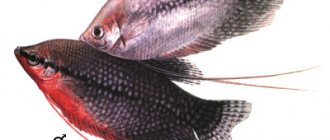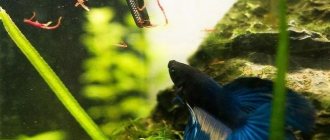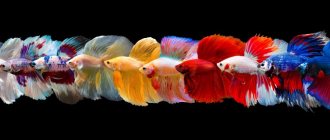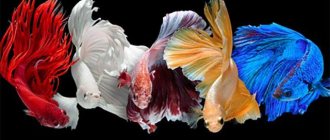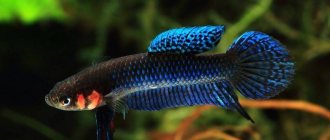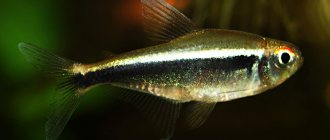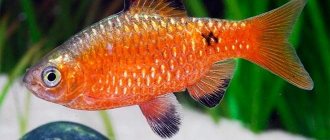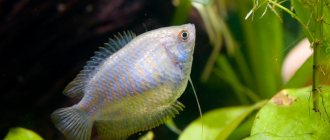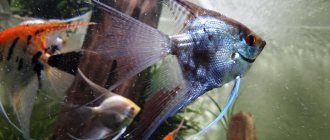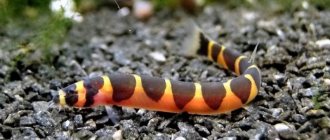Cockerel
The spawning of labyrinths is always a spectacular spectacle. Betta fish are no exception, the reproduction of which will not leave anyone indifferent. In order for the spawning to be successful and for the emerging fry to survive and fully develop, you need to know the nuances of breeding this species.
A male betta fish is busy building a foam nest for his offspring.
Matching
Males reach sexual maturity at 5-6 months. Individuals aged 6-8 months are considered optimal for reproduction. Experienced aquarists recommend getting offspring from fish no older than one and a half years old. By using older breeders there is an increased risk of high fry mortality.
Sexual differences in betta fish.
It is not difficult to distinguish a female betta from a male. Male fish have a slender body and fluffier fins that become longer with age. The female cockerel has a paler color, short fins, and a rounded abdomen. A distinctive feature is the presence of a white speck (ovipositor) near the anus.
The selection of a breeding pair should be taken responsibly. It is better to buy fish from experienced breeders or amateur aquarists. By purchasing cockerels in this way, you can obtain information about their age and genetic characteristics. Pet stores often sell old specimens that have been raised using hormones. The offspring from such sires will have a high mortality rate and congenital genetic defects.
When choosing a pair, you should give preference to fish of approximately the same age and size. The same color is desirable.
14 days before breeding, the couple is separated by placing them in different containers or installing a transparent partition in the aquarium with holes for water circulation. Before breeding, the fish's diet should consist of high-protein foods. The bodies of cockerels form sexual products - caviar and milt. In preparation for spawning, the temperature is kept elevated and the water is partially changed several times.
High-protein fish food is most often food of animal origin. Dry, frozen or live.
During this period, the behavior of the couple should be observed. The fish should be interested in each other, the male is animated, swims in circles, straightens his fins. A little aggressiveness is acceptable. If both individuals constantly attack each other, throwing themselves at the partition, it is better to choose another pair.
Preparing the spawning tank
For breeding bettas, an aquarium with a volume of 20-40 liters, filled with water to a height of 10-15 cm, is suitable. The aquarium must be equipped with a heater, lighting, and a filter. The water should be settled for 3-4 days, with a pH of 6.7-7.3. Hard old water will not work.
At the bottom of the tank for spawning bettas you need to fix a couple of holly plants. Place small floating algae on the surface of the water, in small quantities - riccia, duckweed, watercolor. They will be additional building material for the nest.
You can make a spawning tank for a betta yourself, for example, like in this photo. Here the female was placed in an aquarium with the male in a separate container.
Do not place pebbles or sand at the bottom of the aquarium; fallen eggs can easily get lost in the soil. Equip a grotto or other shelter for the female.
The optimal temperature for the start of spawning is 26-28˚C. The lighting should be dim and the filter turned off. The aquarium is located in a quiet place where no one will disturb the fish.
Simultaneously with preparing the breeding site, you need to take care of food for the fry in the first days of life. A three-liter jar is filled 2/3 with water, placing a piece of banana peel on the bottom. Add a teaspoon of milk. Place the jar in a warm place. After 3-4 days, you can notice the first ciliates that appear. In the summer, ciliates are grown in a garden barrel, putting hay dust in the water.
How we see ciliates with the naked eye and under a microscope.
The pet store buys a culture of microworms, which will be needed a little later. When the baby cockerels grow up noticeably.
Reproduction
Preparing the spawning tank: As a spawning tank, it is better to take an aquarium with a volume of 15 liters, pour 10 liters of water into it, be sure to cover it with a lid - the cockerels jump well. There should be shelter for the female, personally I use ceramic driftwood, floating plants - for me it’s usually pistia, you can add a few branches of nayas or hornwort. We put a heater in the spawning tank - the temperature should be about 26 degrees. You can place almond leaves in the spawning tank, for example - this is one of the spawning stimulants.
Spawning: Then you put the male there - usually he immediately builds a nest. The next day we put the female with him
Attention - the female must be plump, with eggs. The fish are not fed in the spawning area! Usually after 3 - 24 hours, spawning begins, during the process the male “embraces” the female and “squeezes” eggs out of her, simultaneously fertilizing her
Afterwards he releases the female, at this moment she is relaxed and practically goes to the bottom in the same position. The male is brightly colored, while the female, on the contrary, turns pale. In females of dark colors, dark longitudinal stripes may appear on the body. The male collects the falling eggs (they are sinking and white) into the nest and again “squeezes” the female, usually until there are no eggs left in her.
Next, the female hides, as the male begins to drive her away from the nest, because the female can eat the eggs. But it also happens that the female helps the male collect eggs in the nest. After spawning, the female should be removed.
Feed again: At this stage, you need to prepare food for the fry again, again preferably live - Artemia nauplii. You can buy brine shrimp eggs at a pet store or at Ptichka. I usually take a two-liter cola bottle, fill it with ¾ of water, put one and a half teaspoons of regular salt and a teaspoon of brine shrimp eggs, lower it with a spray from the compressor and place it on the aquarium rack, every other day the brine shrimp are hatched, the sprayer is turned off to collect, the crustaceans accumulate at bottom, and they are sucked in with a hose from the compressor. It is better to place 2 bottles with a difference of 2 days, then you will always have nauplii for feeding.
Caring for the offspring: Next, the male takes care of the nest - he eats dead eggs and renovates the nest. There is no need to feed him at this time, and there is no need to change the water either. After a day, the larvae begin to hatch.
At first they hang in the nest, the male continues to look after them, after a day their yolk sac usually dissolves and they begin to swim horizontally - at this moment you need to remove the male and turn on the compressor. Then the first feeding is done - we feed ciliates, if there are none, then you can feed them with food like Sera micron; I don’t recommend boiled egg yolk or boiled liver - they greatly spoil the water.
You need to feed so that there is always food in the aquarium. There is no need to change the water. Gradually, over the course of a week, the temperature in the aquarium should be reduced to room temperature. After 3 - 4 days, the fry begins to take artemia nauplii, but we do not stop feeding ciliates - the smaller fry still eat it. If there is no brine shrimp, you can feed both decapsulated brine shrimp and dry food like Sera micropan.
After a week or a week and a half, you can offer the fry frozen microplankton, and later - cyclops, cut tubifex. As soon as the fry begin to eat brine shrimp, you can gradually raise the water level, and later change the water. If you feed dry food - daily, if live - less often. When the fry reach a size of 1 cm, if you want to grow more fish, the fry need to be sorted into different aquariums, otherwise the larger fry will eat the smaller ones.
Then it is advisable to transfer the fish to a larger aquarium so that they do not drag on. When the fish begin to identify by sex and fight, you need to seat the males in separate containers, and it is better to feed the fish in them with live food. By the age of three months, cockerels are usually fully colored, with some exceptions; males begin to train in nest-building, and they can be placed for spawning at 4-5 months.
Spawning
The male is first introduced into the breeding aquarium. He begins to build a nest from air bubbles, holding them together with saliva and parts of floating plants. The result is a cap of foam that rises above the water. The bright coloring of the partner and the completion of construction are signals that the time has come for the placement of a pregnant female.
10:58
Spawning of cockerels
The cockerel chases the female, delivering sensitive blows. At some point, the cockerel wraps itself around its partner, squeezes the eggs out of its abdomen and pours milk on it. The male picks up the fertilized eggs and carries them to the nest. The mating process is repeated 1-4 times. A sign of the end of reproduction: the male is busy with the nest, the female is hiding in a shelter. The female fish needs to be removed at this time.
If the males do not start breeding, they take measures: raise the temperature to +30˚C, soften the water using peat additives from the pet store, change some of the water. During one spawning, the female lays more than 600 whitish eggs of irregular shape.
The male wraps himself around the female and helps her push out the eggs.
Cockerels are not fed during breeding so as not to spoil the quality of water in the spawning area. This does not have any negative consequences for adult fish.
Breeding cockerels at home
This type of fish is very capable of breeding in a home aquarium. However, this process is often associated with certain difficulties and requires special knowledge and skills.
You will be interested to know how to breed betta fish in an aquarium.
In a separate spawning area
The spawning process begins when you place a female, ready to breed and full of eggs, with a mature male. First, only the male needs to be placed in the aquarium for future spawning, who will build a nest there from algae and other elements available to him in the aquarium.
As soon as a female comes into the male’s field of vision, he begins active courtship of her, manifested primarily by pinching her fins, intimidation and active pursuit throughout the aquarium. Often, the female is initially frightened by this behavior and hides, but, in the end, the male lures her into the nest, where the final fertilization process takes place. This process usually takes from 2–3 hours to several days, provided that all required standards for the aquarium are met.
From the editor: Reproduction and breeding of swordtails
The spawning itself lasts for several hours, during which the male is on top of the female and presses her with his belly on her back to facilitate the release of eggs. The male fertilizes the laid eggs with seminal fluid and secures them in the nest. It is at this point that it is best to remove the female from the aquarium, since the father, as already mentioned, will become overly aggressive and begin to seriously attack the “lady”.
Important! The place in which the male will build a nest is best cleared of stones and other shelters into which the rather small eggs of this fish can roll.
The male will remain at the nest and monitor his future offspring until the fry emerge from the eggs. This process usually takes up to 3 days. Immediately after you notice the appearance of the first fry, it is also better to place the male in a separate aquarium, since, given the aggressiveness of the bettas, he is very likely to attack them.
In a common aquarium
Due to the fact that during the process of spawning and caring for eggs, the male betta, who already has a rather bad character, shows a significant level of aggression towards other inhabitants of the aquarium, it is better not to breed this type of fish in a community aquarium. In addition, if the community aquarium contains any small predatory fish or other small predators, the eggs and fry will be in constant danger, since it may be difficult for the male to keep track of all his offspring.
Find out why the betta fish doesn't eat anything.
It is also necessary to take into account that fish in a community aquarium may suffer due to the switching off of filters and pumps in the first stages after fertilization, which is necessary so that small eggs are not drawn into the mechanical part of the filter.
Raising fry
The male carefully looks after the nest: removes dead eggs, corrects the crumbling edges of the foam cap, and picks up the eggs that have fallen to the bottom. During this period, the aquarium must be illuminated around the clock so that the fish does not fall asleep and some of the eggs do not die.
Baby cockerels in a nest that will soon be abandoned.
After 24-48 hours, the larvae appear; these are not fry yet, but they are mobile and have black eyes. The yolk sac serves as a source of nutrition for the larvae for 3-4 days. Then the larvae develop a tail and the fry begin to leave the nest. At this time, the tired parent is seated.
The beginning of independent feeding of babies is the most crucial moment in raising fry. At this time, the highest percentage of juvenile mortality is observed. The best food for small fish in the first week of life is ciliates.
If it is impossible to obtain live food, it is replaced with store-bought microfeeds diluted in water or egg yolk. This type of food is less digestible by children and greatly spoils the water in the aquarium.
From a week to a month of age, small fish are fed 2 times a day with microworms, vinegar eel or small brine shrimp. You should not get carried away with the latter; overeating can cause damage to the swim bladder in young males. When feeding dry or liquid food, you need to change the water frequently. The film of bacteria that appears on the surface of the water is removed with a sheet of clean paper.
14:10
MALE COCKER FROM 1 TO 12 DAYS!!!
05:05
FISH FRY COCKER - HALFMOON - 2.5 MONTHS#COCKERHALFMOONFISH (MARI MYSTIC NURSERY)
The labyrinth breathing apparatus is formed in fish in 3-4 weeks; until this moment the compressor must work. Every day, using a siphon or syringe, replace part of the water, gradually increasing its level in the aquarium. The temperature is gradually reduced to 22-24˚C.
From the age of three weeks, young cockerels are sorted so that large individuals do not eat the babies. The juveniles are placed in a large aquarium for full growth. At the age of one month, they begin to accustom the fish to cut tubifex.
Little cockerels grow up very quickly.
The period from egg to adult fish in bettas is 5-6 months. But already from 3 months of age the first sexual differences appear. At this time, young individuals have short fins, and it can be difficult to distinguish a girl from a boy. Some specimens begin to show aggressiveness early and should be removed.
How to find the difference between a male and a female?
Zebrafish fry are very similar to each other, it is almost impossible to distinguish them. But in adults the differences are more obvious. Males are smaller and slimmer. Females have a round abdomen. In addition, males are brighter in color and have strong fins. Females are noticeably paler.
From the editor: Panhax content breeding compatibility description photo
If the female's abdomen is swollen, this means that she is ready for reproduction - she releases pheromones to attract a potential partner. Males also secrete hormones that actively stimulate ovulation in “girls”. This is accomplished through the process of releasing homogenate and gonads from the seminal glands into the water. Boys should be in the same tank with girls for eight hours.
Potential problems and benefits
Having become interested in breeding cockerels at home, an amateur must decide whether he is doing this for fun or pursuing certain goals. You can try to breed your own genetic line of fish, selecting from each offspring the producers that best meet the intended standards. Some aquarists breed bettas commercially.
Maybe you will be the one to create a new form of betta fish?
In any case, steps should be taken to ensure that the raised fry are marketed. This could be advertisements on the Internet or establishing contacts with pet stores. Otherwise, the number of young fish will become so large that there will be nowhere to keep them. After all, each couple, with good care, is capable of producing offspring once every 2-3 weeks. Even in the event of the death of a third of the total number of fry, partial culling, after each spawning you can get 200-300 young cockerels.
Regardless of the purpose for which cockerels are bred, it is always an exciting spectacle. Watching a neon-painted male mating dance around a pale female is worth the time and effort.

